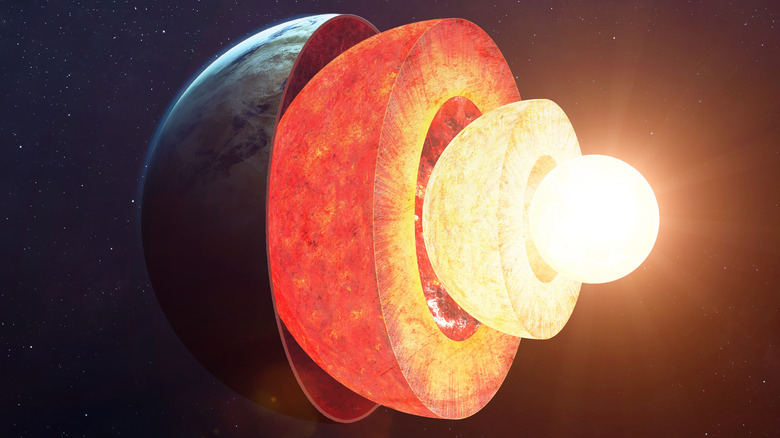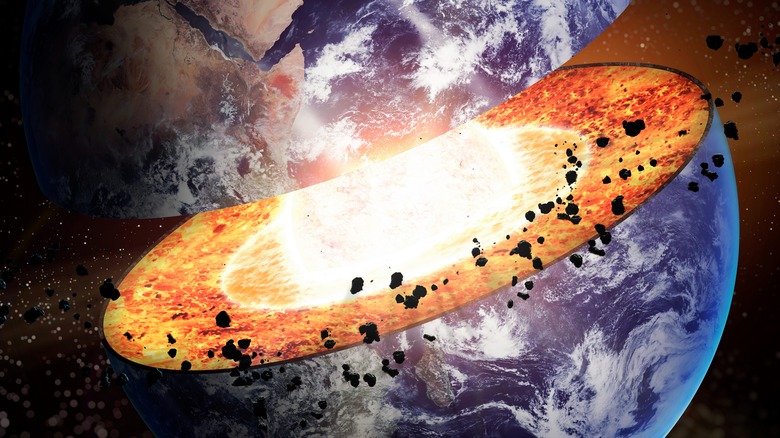Scientists Say Earth's Inner Core Might Be Reversing Its Rotation (So Should You Be Worried?)
There's a lot happening on Earth's surface. With various landscapes, weather patterns, and sights to be seen, sometimes the bountiful beauty on the surface distracts from the entire unique system within the Earth's center. The Earth's core is made up of three main components below the crust. The mantle, the outer core, and the inner core (per National Geographic). To get an idea of just how big the planet is, the core itself is a whopping 1,800 miles beneath the Earth's crust.
The inner core wasn't discovered until 1936 when researchers were studying seismic waves created by earthquakes. They found the inner core to be made up of primarily iron inside a layer of an iron liquid mixed with other elements (via Nature). While it's nearly impossible for scientists to have truly understood how Earth's core worked in the past, it appears that now, the rotation of the core seems to be slowing down and even reversing. However, as detrimental as this may sound, there's a good reason it doesn't appear to be worrying researchers.
The inner core has been slowing down for quite some time
Earth's inner core has an impressive radius of around 2,165 miles and burns hot with temperature ranges from 7,952 degrees Fahrenheit and 10,800 degrees Fahrenheit (per National Geographic). Now Earth's massive center appears to be reversing its rotation. According to the study Multidecadal variation of the Earth's inner-core rotation, conducted by researchers Yi Yang and Xiaodong Song, the core's speed decrease began back in 2009.
"We show surprising observations that indicate the inner core has nearly ceased its rotation in the recent decade," the researchers wrote in the study (via Astronomy). "Our observations suggest not only a pause but also a turning-back of the rotation by a small amount." Data going back to the 1960s shows that the rotation of the core has been consistent from the 1970s into the early 2000s. However, the research also shows another possible slowdown and reversal that took place in the 1970s. The inner core is made almost entirely of metal consisting of iron and nickel. Because of this, according to the study, even slight variations in the Earth's electromagnetic field can be enough to change the core's rate of rotation due to the mantle layer's gravitational effect on the inner core.
The rotational swap seems to occur every few decades
While more research is needed regarding Earth's core, the slowdown and reversal of its rotation have little to no effect on what happens on the surface (per Astronomy). Research indicates that the core rotation switches happen around every seven decades, and the rotation actually reflects on the more observable changes that take place on Earth's surface. The climate patterns observed match up to the behavior of the inner core below, leading researchers to believe that the inner core's movement schedule is linked to the Earth's outer layers (per Science Alert).
Yang and Song commented on the finds in their study published in Nature Geoscience, noting, "These observations provide evidence for dynamic interactions between the Earth's layers, from the deepest interiors to the surface." The research conducted on the inner core is beneficial to better understand how our planet functions. However, the process is tricky, and there's much more to learn, as another researcher involved in the study, Hrvoje Tkalcic, a geophysicist at the Australian National University, said in a statement published by CNN. "You can think of seismologists like medical doctors who study the internal organs of patients' bodies using imperfect or limited equipment. So, despite progress, our image of the inner Earth is still blurry, and we are still in the discovery stage."
There's nothing to worry about — so it seems
Earth's core is meticulously maintained by the other layers of the planet as the iron from the outer core crystallizes and changes the density of the liquid surrounding it. This change in density creates the churning motions necessary within the inner core to maintain Earth's magnetic field (per Nature). We, on the surface, don't realize all of this is happening thanks to the outer core, which separates the Earth's inner workings from the crust, allowing the core to spin however fast or slow it needs.
So while the Earth's inner core slowing down and even changing directions may sound like an event of cataclysmic proportions, it's just the Earth doing Earth things. These changes in pace are to be expected around every seven decades or so, according to the multidecadal study conducted by Yi Yang and Xiaodong Song. Though the inner core is about the size of Mars and is at a depth that makes it nearly impossible to study on a regular basis, so the understanding of the patterns and behaviors it exhibits is always subject to change.



